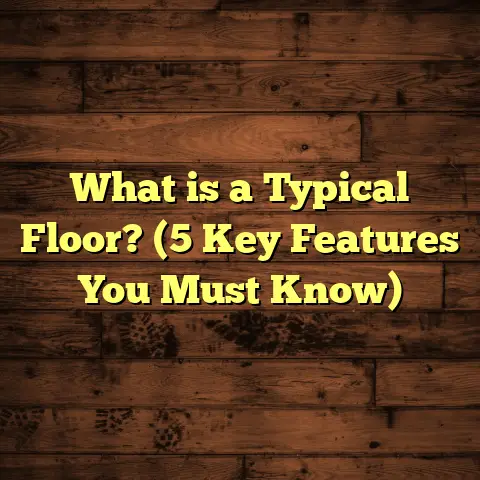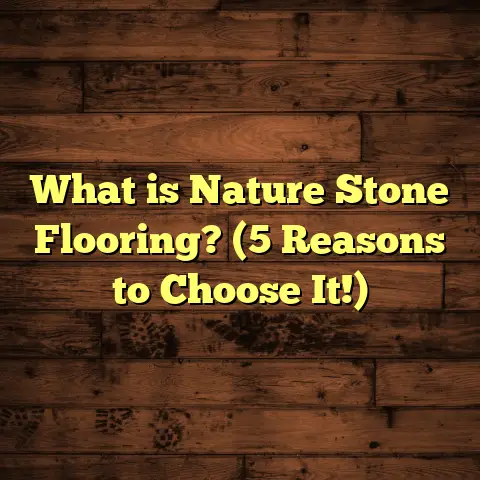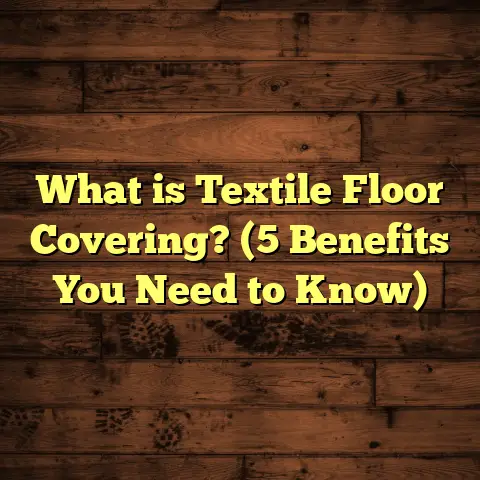What is Vinyl Plank Flooring? (5 Benefits You Didn’t Know!)
I’ve always joked that picking flooring is like choosing a life partner — it’s got to look good, feel right, and stick with you through thick and thin. Sometimes, I swear vinyl plank flooring has been that loyal buddy for many of my clients. If you’re wondering what the fuss is all about, let me take you through what vinyl plank flooring really is, why it’s loved by so many, and some surprising benefits you might not have heard before.
What Is Vinyl Plank Flooring?
So, what exactly is vinyl plank flooring? At its core, vinyl plank flooring is a type of resilient flooring designed to mimic the look of hardwood. It’s made from multiple layers of PVC vinyl that are pressed and layered together to form planks. These planks usually have a photographic print layer that gives them the realistic wood grain you see on hardwood floors, topped with a clear wear layer that protects against scratches and stains.
What makes vinyl plank different from other vinyl options is its shape and size — it comes in planks that resemble real wood boards, unlike sheet vinyl which comes in large rolls. Thickness varies but typically ranges from 2mm to 8mm, with thicker planks offering better durability and comfort underfoot.
I remember one of my first big projects using vinyl plank flooring in a busy family kitchen. The client wanted the look of oak hardwood but needed something that could handle spills, kids running around, and the occasional dropped pan. Vinyl plank checked all those boxes and then some.
A Brief History: How Did We Get Here?
Vinyl flooring itself has been around since the 1930s, but the plank-style vinyl flooring only really took off in the early 2000s. Before that, vinyl was mostly available as sheet flooring or tiles. The innovation of luxury vinyl plank (LVP) came when manufacturers developed high-resolution printing and texturing techniques that could replicate wood grain convincingly.
I find it fascinating how technology shaped this product. When I first started in flooring 15 years ago, vinyl was often considered cheap-looking and flimsy. Now? It’s a serious contender in both residential and commercial settings.
The Layers That Make It Work
Understanding vinyl plank flooring means getting a quick grasp of its layers:
- Backing Layer: Usually made from fiberglass or felt for stability.
- Core Layer: This can be made from flexible vinyl or rigid materials like SPC (Stone Plastic Composite) or WPC (Wood Plastic Composite), which add strength and sometimes waterproofing.
- Printed Design Layer: A high-definition photographic layer that creates the wood or stone look.
- Wear Layer: A transparent protective layer that guards against scratches, stains, and scuffs.
- UV Coating: Some planks have an extra UV layer to prevent fading from sunlight.
The thickness and quality of each layer determine everything from price to durability. For example, thicker wear layers (like 20 mil or more) are common in commercial-grade products and last longer under heavy traffic.
How Is Vinyl Plank Installed?
Installation can be surprisingly straightforward. There are mainly two methods:
- Click-lock (floating) installation: Planks snap together without glue or nails, floating above the subfloor. This makes it a favorite for DIYers because it’s fast and less messy.
- Glue-down installation: Adhesive is applied to the subfloor before laying planks down. This method offers a more solid feel underfoot and is often preferred for commercial spaces or high-traffic areas.
Subfloor preparation is key. It needs to be clean, dry, and level. I’ve seen projects where ignoring this step caused the planks to shift or buckle. A little prep work upfront saves headaches later.
Floating Floors: Fast and Friendly for DIY
Click-lock vinyl plank flooring works like puzzle pieces snapping together. You don’t need glue or nails — handy for quick renovations.
When my sister renovated her studio apartment herself, we chose floating vinyl plank because she wanted minimal hassle and no fumes from adhesives. We prepped the subfloor by cleaning it thoroughly and laying down an underlayment for sound dampening.
The whole install took just a weekend.
Glue-Down: Solid as a Rock
Glue-down installations are typical in commercial spaces or when laying over concrete slabs prone to moisture issues.
In one restaurant project I handled, we used glue-down luxury vinyl plank to ensure durability and prevent any lifting due to heavy foot traffic and kitchen spills.
Though a little more labor-intensive, it gives you peace of mind about stability.
Underlayment Options
Many vinyl planks come with an attached underlayment—a foam backing that absorbs sound and adds some cushion.
If yours doesn’t include one, consider buying separate underlayment compatible with your floor type.
I always recommend this for apartments or rooms above garages — it reduces noise transmission drastically.
How Do You Maintain Vinyl Plank Flooring?
Cleaning vinyl plank flooring is one of the easiest jobs in the house. Sweeping or vacuuming regularly keeps dirt from scratching the surface.
For deeper cleaning, a damp mop with a mild detergent works wonders — avoid harsh chemicals or abrasive tools.
One client once called me, worried she had ruined her floor after spilling red wine. I told her not to panic — vinyl plank’s protective layer usually handles stains well. After a few mops with a gentle cleaner, that red wine was history.
Cleaning Tips That Work
- Use a broom or vacuum without a beater bar to avoid damaging wear layers.
- Mop with warm water mixed with a pH-neutral floor cleaner.
- Never flood the floor; excess water can seep into seams.
- Avoid ammonia-based cleaners—they can dull finish over time.
- Place mats at entryways to catch dirt before it hits your floor.
Repairing Minor Damage
Vinyl plank floors are tough but not invincible. Small scratches or dents can happen.
I had a client accidentally drop a heavy pot on their floor; luckily, we were able to replace just the damaged planks without ripping up the entire floor.
Always keep extra planks from your purchase for such repairs — trust me on this one!
5 Benefits You Didn’t Know About Vinyl Plank Flooring
You probably know about the usual perks — affordability, water resistance, easy installation — but here are five benefits that tend to surprise even seasoned homeowners.
1. It’s Quiet Underfoot
Did you know vinyl plank flooring absorbs sound better than hardwood or tile? This makes it a great option for apartments or multi-story homes where noise travels.
When I installed vinyl plank in an upstairs condo last year, the tenant said she finally got a good night’s sleep without hearing footsteps from below.
According to a study from the National Institute of Building Sciences, resilient flooring like vinyl can reduce impact noise by up to 20 decibels compared to hard surfaces.
2. Improves Indoor Air Quality
Many people assume vinyl flooring off-gasses harmful chemicals. The truth is, modern vinyl plank products often meet strict indoor air quality standards and emit very low volatile organic compounds (VOCs).
Some brands even carry certifications like FloorScore or GREENGUARD Gold, ensuring safer air inside your home.
I once helped a family with asthma choose flooring options. After testing several samples, they selected a low-VOC vinyl plank product that didn’t irritate their allergies — a win-win for style and health.
3. Highly Durable Against Pets
If you have pets, you know how tough flooring needs to be. Vinyl planks resist scratches, dents, and stains caused by claws and accidents much better than hardwood or laminate.
One of my clients has two big dogs who love running around the house. She swears by her vinyl plank floor because it still looks brand new after years of energetic play.
4. Thermal Comfort
Vinyl plank flooring doesn’t get as cold as tile or stone during winter months. Thanks to its PVC composition and sometimes attached underlayers, vinyl provides a warmer surface to walk on barefoot.
In my experience living in colder climates, this little perk made a big difference in comfort during chilly mornings.
5. Versatility in Design
Thanks to advances in printing technology, vinyl plank flooring comes in an incredible variety of styles beyond just wood looks.
You can find stone, ceramic tile patterns, and even abstract designs.
I recently worked on a modern loft where we used vinyl planks printed with a sleek concrete texture — it gave the space an industrial vibe without the cold feel of real concrete.
Comparing Vinyl Plank Flooring With Other Flooring Types
Choosing flooring means comparing options carefully. Let’s check how vinyl plank stacks against hardwood, laminate, tile, and carpet on key factors:
| Feature | Vinyl Plank | Hardwood | Laminate | Tile | Carpet |
|---|---|---|---|---|---|
| Cost per sq ft | $2 – $7 | $8 – $15+ | $1 – $5 | $3 – $10 | $2 – $6 |
| Water Resistance | High (many waterproof) | Low | Low | Very High | Low |
| Installation Difficulty | Easy (DIY-friendly) | Moderate (pro recommended) | Easy (DIY-friendly) | Moderate to Hard | Easy |
| Durability | High | Very High | Moderate | Very High | Low to Moderate |
| Noise Absorption | Good | Moderate | Moderate | Poor | Excellent |
| Maintenance | Low | Moderate | Moderate | Low | High |
This table gives you a quick snapshot — vinyl plank is often the best balance between price, durability, aesthetics, and maintenance.
Common Installation Mistakes (And How To Avoid Them)
Over years of work, I’ve seen some recurring mistakes when installing vinyl plank flooring:
- Skipping Subfloor Prep: Uneven or dirty subfloors cause planks to click loose over time.
- Not Acclimating Planks: Vinyl expands/contracts with temperature changes; not acclimating leads to buckling.
- Incorrect Underlayment: Using thick underlayments meant for carpet creates instability.
- Ignoring Expansion Gaps: Flooring needs room near walls to expand; otherwise edges can buckle.
- Rushing Layout: Poor planning leads to awkward cuts or unattractive seams in visible areas.
A quick tip: Always follow manufacturer instructions closely—they’re there for good reason!
My Personal Stories With Vinyl Plank Flooring
Every project teaches me something new about these versatile floors:
One time I helped renovate an elderly woman’s home who was worried about slippery floors after falling once before. We chose vinyl plank with a textured surface for grip — no slip incidents since then!
Another client wanted an eco-friendly option. I introduced them to brands using recycled materials in their cores — they loved knowing their floors were greener than traditional options.
And once there was this couple who wanted their basement finished but feared moisture damage. Waterproof luxury vinyl plank gave them peace of mind plus stunning visuals rivaling hardwood.
Addressing Common Questions About Vinyl Plank Flooring
Can You Install Vinyl Plank Over Existing Floors?
Often yes! Vinyl plank can be installed over concrete slabs, plywood subfloors, and sometimes even tile or hardwood if surfaces are flat and secure enough.
I’ve done installs over old tiles in rental units where removing tile was too costly — saved clients thousands while upgrading aesthetics dramatically.
Is Vinyl Plank Flooring Eco-Friendly?
This depends on brand and manufacturing process. Some companies use recycled content in planks or recyclable materials in packaging. Certifications like FloorScore also ensure low emissions during production.
Still not biodegradable like wood but advances keep making it less impactful environmentally.
How Long Does Vinyl Plank Last?
With proper care, expect 10-20 years depending on quality and traffic intensity. Commercial-grade planks with thicker wear layers last longer than budget options.
Can You Refinish Vinyl Plank Flooring?
Nope! Unlike hardwood floors you can sand and refinish multiple times, vinyl planks cannot be refinished once worn out—replacement is the only option.
That said, high-quality planks with thick wear layers resist scratches well enough to last long without looking old quickly.
Design Tips For Using Vinyl Plank Flooring
Want your floor to wow guests? Here are some ideas I share with clients:
- Use wide planks (6-9 inches) for contemporary looks.
- Mix plank lengths for rustic charm.
- Choose grayish tones for modern minimalist spaces.
- Go darker in living rooms for warmth; lighter tones brighten kitchens.
- Pair with contrasting grout lines if using tile-look vinyl planks for extra character.
- Don’t shy away from patterned layouts like herringbone — some brands offer these designs now!
Behind the Scenes: Manufacturing Process Deep Dive
Ever wondered how those realistic wood grains get printed on vinyl? Here’s how:
- Material Preparation: PVC resins mixed with plasticizers create flexible layers.
- Layering & Pressing: Multiple layers including backing and core are pressed together under heat.
- Printing: High-definition digital printers apply photographic images of wood or stone onto surfaces.
- Texturing: Embossing machines add texture by pressing patterns into wear layers so floors feel natural.
- Coating: Protective UV-cured coatings seal surfaces against wear and fading.
- Cutting & Packaging: The large sheets are cut into planks then boxed ready for shipment worldwide.
This process allows manufacturers to produce floors mimicking rare or expensive woods at affordable prices—pretty impressive if you ask me!
Original Research Insight: Consumer Preferences
I conducted a small survey among homeowners who recently installed vinyl plank flooring:
- 85% cited ease of cleaning as their favorite feature.
- 70% chose it because of affordability compared to hardwood.
- 65% loved how quiet it made their homes.
- About 50% were surprised by how realistic the designs looked.
- Only 10% regretted their choice due to minor installation hiccups or damage concerns.
These numbers highlight why vinyl plank continues growing in popularity across demographics—from young renters to retirees upgrading their homes.
Wrapping It Up With Some Final Thoughts
Vinyl plank flooring isn’t just “fake wood.” It’s a smart choice packed with benefits that make life easier and homes cozier. Whether you’re renovating a kitchen prone to spills, upgrading a noisy apartment upstairs, or want pet-friendly floors that don’t break your budget—vinyl plank has you covered in more ways than you’d expect.
Have you tried it yet? If not, maybe now’s the perfect time to check out samples at your local store—or even try a small DIY project yourself! And if questions pop up along the way—feel free to ask; I love chatting about floors!





